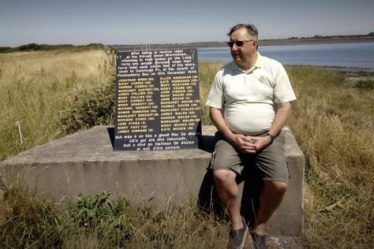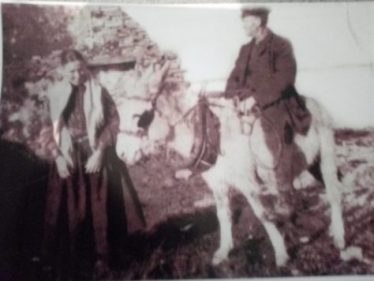


Photo courtesy of Mary Hamilton
Cammoge Point in Poulnasherry Bay looks a very pleasant place with the tide full in however on a cold windy dark December afternoon in 1849 calamity struck.
Located near Clarefield, not far from Kilkee, the isolated stretch of stony beach was once a short cut from the extreme west of the county to Carnacalla near Kilrush. About three-and-a-half miles could be shorn from the journey to Kilrush by crossing the mouth of Poulnasherry Bay. The route was availed of for hundreds of years and, in fact, a ferryboat operated from Cammoge Point until 1927.
However, the picturesque point was the scene of total devastation on December 12, 1849, when a boat, returning from Kilrush, sank. Forty-one people drowned within a mere 30 yards of completing the journey.
In a detailed contribution to The Other Clare in 2006, historian Paddy Nolan outlined the nature of the tragedy and the context that led to it. On the morning of the multiple drowning, the boat, which was designed to carry 12 people, sailed to Kilrush.
The majority of those on board were hoping to be admitted to the workhouse in the town of Kilrush. The famine had ravaged their homesteads and left them completely destitute.
The writings of [historian] Ignatius Murphy stated that
“ In 1848 in an auxiliary workhouse in Ballyerra [Kilrush], there were over 1,000 children. They were being looked after by two paupers, who themselves were ordinary inmates,”
12 children who drowned that winter evening did not last long in the bitter waters of Poulnasherry Bay.
After docking in Carnacalla on the morning of December 12, 1849, the famine-stricken occupants disembarked and walked the two-mile trek to Kilrush.
“They found the streets swarming with paupers, while demented shop keepers and house owners tried to steel themselves,”
“At the workhouse gate they were met by Daniel O’Gorman (relieving office for Moyarta) who told them to wait at the gate while he pleaded for their relief. The result was the admission of a few. It then got so dark that it was necessary to have candles lit. This was the signal, even for diehards, to go home, most of the ferry passengers having already left,”
Loading the boat at Carnacalla was haphazard, due to the fact that it was the last ferry that day. From halfway, it was noticed that water was coming in.
The ferryman, Thomas Brew, survived the calamity and told an inquest, held the following day, what had transpired.
“When only 30 yards from dry land, she filled and sank under us. I took off my jacket and jumped out and swam about a boats length from the bow of the boat. I returned and took hold of the side and went hand over hand to the stern, where Laurence McNamara was holding,” Thomas Brew recounted.
Laurence McNamara was a boatman and was the last person to board the doomed vessel.
“A boat owned by Mr Cox [local magistrate] came to our rescue and also rescued a woman and a very young child,” Thomas stated in his testimony.
Local press reports starkly described the scene at Cammoge Point.
“Captain Kennedy [Kilrush-based Poor Law Inspector] was early on the spot with Dr O’Donnell, the medical officer of the union. But the night being dark and stormy and the boat being at the other side of the ferry, they were unable to cross. A more fearful sight never presented itself to the human gaze. Old and young, parents and children lay inter-mixed with the seaweed and rocks, where the ebbing tide had left them,” one report said.
Another report was equally moving.
“There were to be seen the mother and her child clung together, the arms of the child clasped around the mother’s neck. Even when brought to land, it was difficult to sever the iron grasp of death,” the report read.
“We cannot be sure where exactly the victims were buried. Many were buried in a mass grave at Kilnagalliagh as suggested by [historian] Ignatius Murphy. The coffins were supplied by Captain Kennedy. It’s possible that if some of the dead were recognised by their relatives, they could have taken the body, with the donkey and car, to their own burial plot,”
Just one victim, 20-year-old John O’Brien, was buried in his own plot in Kilnagalliagh graveyard. The inscription on his grave is visible to this day.
“Erected by Patrick O’Brien in memory of his beloved son John who was drowned at the ferry Dec 12th 1849 aged 24 years. May he R.I.R. Amen”
Yes, you spotted the mistake – it should have been R.I.P. which makes this gravestone a curiosity.
There was no memorial to the other victims, until 2013 when a monument with the victims names was unveiled on 6th May 2013 by Mr. Paddy Nolan at the site of the disaster at Cammoge during the 164th anniversary commemorations of the Famine which that year centred on Kilrush as each May somewhere in Ireland there is a National Famine Commemoration Day / Commemoration Week .Mr Paddy Nolan now deceased was a vet and a well known local historian.
The inquest was held the following afternoon. It was heard by Coroner Francis O’Donnell from Kilkee. He had been summoned by Captain Kennedy. It is not certain where exactly the inquest was held, although in all likelihood it was held in Mount Pleasant, the home of Magistrate Cox and near to the scene of the disaster.
Tim Keane, from Clarefield, said he had been a boatman on the ferry for 15 years although he wasn’t on board when it sank.
“I knew the boat to be leaky for the past month,” he revealed. He also told the inquest the boat had been old when he started working as a ferryman.
In the House of Commons in London, pressure from Poulett Scrope MP resulted in the appointment of a Select Committee to inquire into the administration of the Poor Law in the Kilrush Union. The inquiry started on May 30 1850 and sat for 13 days, usually twice a week.
During Captain Kennedy’s testimony, chairman Poulett Scrope asked him about paupers who had travelled considerable distances but were refused outdoor or indoor relief at the Kilrush Workhouse.
“Was that the case with some of the paupers who were drowned at the ferry in the month of December last?” the MP queried.
Captain Kennedy said the relieving officer, Daniel O’Gorman, had confirmed this before the coroner’s jury. Captain Kennedy was then asked whether those who drowned had been refused relief in Kilrush or had their pleas not been heard?
Captain Kennedy was unable to answer the question, as he had not been present at the workhouse for long enough on December 12, 1849.
“Part of the instructions to a relieving officer was that, in cases of urgent necessity, he should admit an applicant even without seeing a [workhouse] guardian. Some members of the Select Committee fastened on to this in an apparent attempt to scapegoat O’Gorman,”
Captain Kennedy however told the Select Committee that admissions by a relieving officer were only valid until the next meeting of the workhouse guardians.
Poignantly, some of the older people who drowned at Cammoge Point, had lived through West Clare famines in 1817, 1822, 1830, 1837 and 1842.
Ferryman’s House
Built in 1700 for the use of the ferryman, a section still exists and was cleared of trees, ivy and scrub to commemorate the 164th Anniversary of the Famine. However nature has taken over it again. The Brew family lived here when the Ferry Disaster of 1849 took place. Blame for the disaster was put on the shoulders of Brew the ferryman. The last family to live here were Martin Conway, the ferryman and his wife Margaret and the black and white picture is one of the few pictures to exist of them. They had no issue. The ferry stopped in the late 1920s and the house was abandoned and left to deteriorate when the Conways left in early 1930s.
![mountpleasant c.1840 Map showing Poulnasherry Bay Ferry Crossing c.1840 | 'Data from the [6 inch historic maps] accessed through the Heritage Maps Viewer at www.heritagemaps.ie, [21-2-2020)]'.](https://heritage.clareheritage.org/wp-content/uploads/sites/6/2020/02/mountpleasant-c.1840-374x236.jpg)




Comments about this page
I’m descended from the Cox family and proud they were able to save a few lives. I’m also descended from Brews so the story carries meaning to me. I visited Kilnagalliagh and saw the grave mentioned.
Add a comment about this page